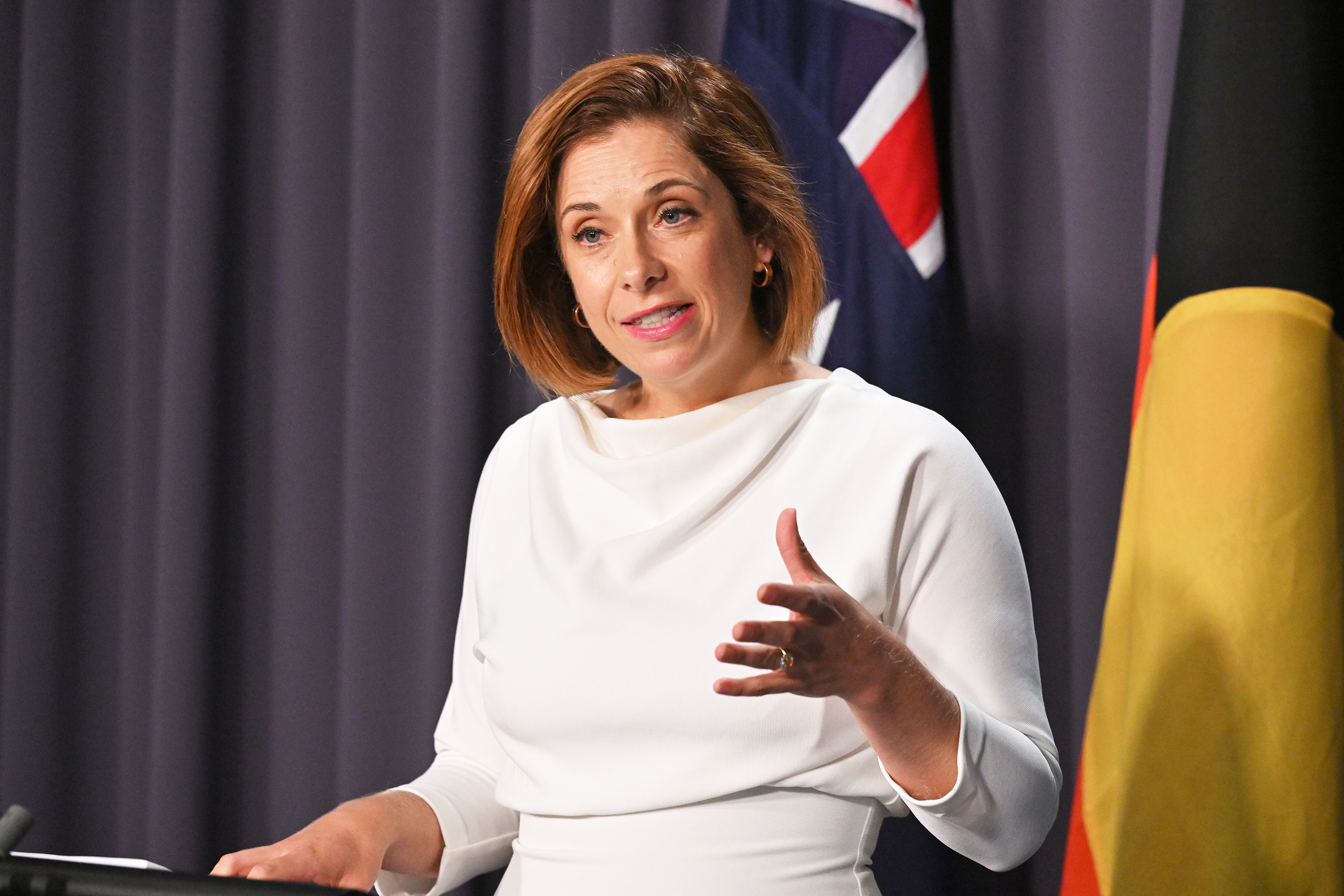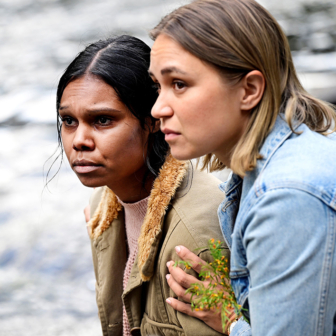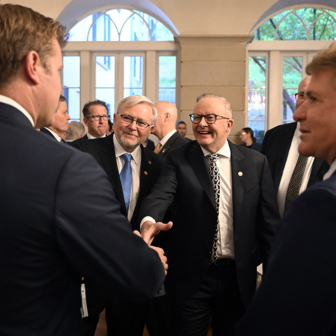Australia’s new communications minister Anika Wells had some big files in the in-tray she inherited in May. Among the most pressing was the future of free-to-air TV.
Her predecessor, Michelle Rowland, declared ominously in October that broadcast TV was “entering a period of unmanaged transition.” Rowland “believe[d] in the broadcasting platform,” but a sustainable future would require “changes to the way… broadcasters operate and the way they reach their audiences.” Despite deep cost-cutting, the shift of viewers from linear to on-demand content services and the decline in advertising revenues were “putting some broadcasters in a position where they can’t keep the doors open, for certain services.”
A few months earlier, the company delivering Network 10’s channels to Mildura had announced it was turning off the transmitter and handing back its licence. Viewers who wanted those channels could watch the Sydney versions via the 10 Play app or website. The Seven, Nine, ABC and SBS over-the-air signals would still be available in the area. This was what an “unmanaged pathway” would look like. Staying on it, said Rowland, would lead to “more service closures in remote and regional markets, where the financial pressures are greatest.” This trend “may eventually manifest in the larger cities.”
The financial pressures noted by Rowland became visible again in June when Seven briefly disappeared from the airwaves of southeast South Australia during a dispute between the network and its regional licensee — further evidence of the precarity of regional television in a shrinking ad market.
Britain is further down the same path. Ofcom, which regulates TV, radio, online and postal services and allocates radiofrequency spectrum, says the system of “public service media” in Britain is “under serious threat.” By public service media, it means not just the publicly funded TV and radio broadcaster, the BBC, with its 2025–26 revenue of nearly £4.5 billion (more than A$9 billion) but all the other free-to-air broadcasters as well: ITV and STV in Scotland, Channel 4 and the Welsh language S4C, and Channel 5, which is owned, like Australia’s Ten, by Paramount Global.
Young British children spend more time watching YouTube than broadcast TV and less than half of sixteen- to twenty-four- year-olds watch any broadcast TV at all in an average week. “[I]n a world dominated by global streaming platforms, public service media risks becoming an endangered species, and time is running out to intervene to protect it,” says Ofcom’s director of broadcasting and media. This matters because public service media is “stitched into the cultural fabric of UK society. It starts conversations, educates and informs, and brings us together in moments of national importance.” It also “supports the UK’s production sector — a global leader which contributes meaningfully to the creative economy and attracts significant investment into the UK.”
Ofcom has proposed a “six-point plan” that includes remarkable steps to save an industry that dominated the media scene a little over two decades ago. Public service broadcasters “should work urgently with YouTube” to ensure their content is “prominent and easy to find on the platforms, and on fair commercial terms.” If YouTube doesn’t cooperate then the British government “should consider” new laws to compel the platform to increase visibility of public-service television content.
By early next year, meanwhile, “urgent clarity” is needed from the government about the future of the digital terrestrial TV transmission network: leave decisions any later and “the investment and innovation needed to put universal TV distribution on a sustainable footing [for] all audiences” is at risk. Decisions are also required about extra government money for specific program genres: Ofcom recommends priority to “socially valuable but commercially less viable genres, such as news, local news and children’s content.” These trusted, original programs “reflect British culture and bring the country together.”
These recent statements add to Ofcom’s high-profile interventions in television policy. Last year the agency released a major report that forecast several scenarios for British television, including the switch-off of broadcast television “over the 2030s” or its evolution into a slimmed-down “nightlight” service carrying only a few essential channels. Ofcom was signalling here that the economic model of broadcast television was unsustainable. Policy change was urgently required.
Ofcom’s argument about the pressing need for a “managed transition” in television preceded Minister Rowland’s more cautious statements by several months. But it is clear both countries face the same challenge: the steady, structural decline of the broadcast television model.
Broadcast television has been an “endangered species” for a long time. The dangers have come from different sources. In the mid-1990s, Australians finally got the multichannel pay TV services available years earlier in overseas markets. These provided new buyers for programs and new spots for TV advertising while accelerating the fragmentation of viewing that started when video-cassette recorders and games consoles were first connected to TV screens. Telcos Telstra and Optus entered the TV business, rushing out new cable networks and investing heavily in sports and other programming. Foxtel became a bigger business than any of the free-to-air operators, although it never attracted more than a third of Australian households, and its owners remained big but familiar locals until British-based streamer DAZN acquired it earlier this year.
The early internet promised what some envisaged as a “Celestial Jukebox.” Everything would be available to everyone, everywhere. Movies, TV programs, short films, music, books, whatever. If content had been created, it would be stored and discoverable, viewable, readable, listenable. A lot of content did become available online, but much, much more was created afresh, especially for the video-sharing site called YouTube, launched in 2004 and acquired the following year by search giant Google. The genres were both familiar and novel. Audiences watched, listened and uploaded, sometimes adding to the time they spent with broadcast media and sometimes substituting for it. Advertisers flocked to the site and to other social media platforms hosting video.
Streamers, too, attracted eyeballs and revenue. The US giant Netflix launched in Australia and New Zealand in 2015 and others followed. These were more like on-demand television services, initially offering drama, documentary, children’s shows and other well-established genres. Over time, they became even more like TV, commissioning exclusive titles, introducing advertising, acquiring rights to live sporting events, moving into genres like real crime, entertainment and reality. Ampere Analysis’s Guy Bisson, speaking at a Future of TV Advertising event in Sydney in April, called this the “broadcastification” of streaming.
The other potent new form of competition for TV broadcasters comes from the very tools that display their services: smart TVs. No longer dumb devices that simply translate digital code embedded in electrical signals into pictures and sounds, TV sets have become platforms. This enables consumer electronics manufacturers to earn revenue through ads carried on the home screen and on their own streaming channels: Samsung TV Plus now offers around 150 channels in Australia. Revenue also comes from content sales, rentals, and commissions, and from prominence fees for third-party apps. Manufacturers gather and control data about what is being watched on their screens that helps them to target their advertisements and services.
For TV broadcasters, smart TVs are a mixed blessing. They have generally loved the trend towards bigger screens, because this has helped to refocus fragmented household attention on a premium screening environment, perfect for live, “event” television. But these mighty, wall-mounted screens have ushered Samsung, LG, Hisense, TCL and Sony into the broadcasters’ revenue and customer relationships as well.
The Coalition’s most recent communications minister, Paul Fletcher, published a green paper nearly five years ago containing proposals to “modernise television regulation in Australia.” Attempting to tackle the problem of the long-term sustainability of the free-to-air industry in a world where online streaming of TV was surging, the paper proposed a kind of reverse incentive. If enough TV broadcasters were interested in squeezing their transmissions down to a smaller number of channels, thereby using less radiofrequency spectrum, the federal government might be willing to lighten their tax burden and hand them some of the proceeds from auctioning the vacated frequencies. It was complicated, the impacts were uncertain, and the proposals were not well received by broadcasters. Nothing came of the plan.
Under Labor’s Michelle Rowland change occurred in several areas. The most significant legislative initiative was a “prominence framework” that will commence in 2026. It is intended to ensure Australian audiences can easily find and access local free-to-air TV services and apps — ABC iView, SBS On Demand, 10 Play, 9Now, 7Plus — on the home screens of imported smart TVs that would otherwise prioritise the services of overseas media and technology giants. The commercial networks welcomed the outcome, as did the ABC and SBS, which regard prominence as an essential protection for public-service broadcasting. Further changes to legislation last year were designed to enable WIN and other broadcasters to seek operational efficiencies by consolidating services onto a single transmitter.
Licences for community TV services in Adelaide and Melbourne were extended beyond their 30 June 2024 expiry date, enabling those services to stay on air until another use is identified for their frequencies. An audit of TV infrastructure in remote and regional areas was undertaken and funding and administrative arrangements were extended for seven years so that the viewer access satellite television service, or VAST, continues to provide commercial and national free-to-air services to the estimated 1.5 million viewers in remote and poorly served locations who rely on it.
Rowland’s big commitment in October 2024, though, was not delivered before the election. A discussion paper was to be released for consultation in early 2025, “explor[ing] pathways for the future of television, shaped by the possibility of realising a digital dividend.” A digital dividend is what was reaped after broadcasters shifted from analogue to digital transmission between 2001 and 2013. The new technology enabled more efficient use of spectrum and a large band of frequencies was reallocated and auctioned mainly to support better mobile broadband. TV viewers got more TV; mobile users got faster broadband speeds and larger data caps; the Treasury got a lot of money.
The minister was crystal clear. She was “not [her emphasis] announcing that the Government has identified, or decided to yield, a digital dividend.” But she was “putting, front and centre, the important question of what the future of television may be.” It was “an essential platform in Australia, and we need a mature and measured discussion to plan its future.”
The technologies available to support a second digital dividend — such as higher-resolution DVB-T2 broadcasting — are not as revolutionary as those deployed for the first, and the TV industry that will need to pay for them is not as rich. Some efficiencies are possible but everything will come at a cost — to broadcasters, to viewers, and perhaps even to the government. There will not be more broadcast TV: there may even be a bit less in some places. Well down the track, there will probably be further improvements to mobile and other wireless services but alternative spectrum users are unlikely to pay as much for vacated spectrum as they did more than a decade ago.
This second Albanese administration has already seen a little more of what “unmanaged transition” looks like. The AFL decided no free-to-air footy would be shown on Saturdays this season in Victoria, Tasmania and the Northern Territory, although it has scheduled more of the Thursday night games that are shown live on 7. Only Amazon subscribers got to watch the biennial summit of men’s cricket, the World Test Championship final in June, where Australia played South Africa at Lord’s. Then, as noted earlier, some South Australian country viewers temporarily lost access to Seven’s channels, including Thursday and Friday night AFL, while the local broadcaster and Seven brawled over commercial arrangements.
Overseas, the French public service broadcaster France Television has done a deal with Amazon Prime to carry its free-to-air channels and its commercial rival TF1 has made a similar arrangement with Netflix. This follows the closure in 2022 of Salto, a streamer designed as a common platform for French broadcasters. The new deals represent a radically different kind of future for public service media, with a handful of channels embedded within a vast universe of content branded and supplied from elsewhere.
None of these threats to what is now free-to-air are directly the fault of governments, but electors in Australia and elsewhere are likely to ask what is being done about them. Ofcom’s call to arms is a further sign that the stakes for TV broadcasters everywhere, and especially for the distinctive programs they offer, are getting very high indeed.
Michele Rowland and Paul Fletcher both spent a lot of time in and around media before being allocated the communications portfolio, Rowland as a commercial lawyer acting for broadcasters and telcos, Fletcher as a senior executive with Optus. The media marketplace in Australia and overseas is serving up a crash course to their successor. •




